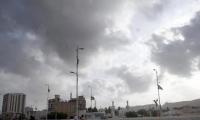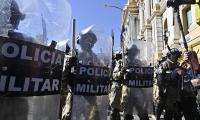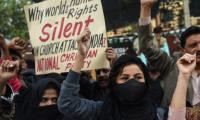ISLAMABAD: Federal Finance Minister Muhammad Aurangzeb unveiled an expansionary budget proposal of Rs18.8776 trillion for FY24-25 on Wednesday, featuring a record-high deficit of Rs8.5 trillion, which is broadly perceived to align with the International Monetary Fund (IMF) guidelines.
The budget, which many believe is designed to meet IMF requirements for securing another bailout of $6 to $8 billion under the medium-term Extended Fund Facility (EFF), marks a 25 percent increase over the outgoing fiscal year’s outlay.
Despite its expansionary nature, the government has proposed historically high additional taxes amounting to Rs3.718 trillion through various adjustments and new levies, potentially increasing the burden on already strained taxpayers. The budget includes raised taxes on salaried classes and removal of certain tax exemptions.
The expansionary budget aims to increase spending but may hinder efforts to control inflation. Additionally, higher taxes could exacerbate the price situation. The budget does not mention any austerity measures in government expenditures but rather focuses on increased spending.
In his budget speech in the National Assembly, Finance Minister Aurangzeb stated, “The previous IMF programme was ending, and a new deal was essential to prevent a default.” He added discussions are underway with the IMF to secure another Extended Fund Facility (EFF). The new programme aims to achieve macroeconomic and fiscal stabilisation, increase foreign exchange reserves, ensure sustainable debt levels, and implement reforms in the power sector and restructuring and privatisation of state-owned enterprises (SOEs).
The historic high deficit will be financed through commercial and euro bonds and domestic bank financing. Although, the expansionary budget aims to stimulate economic activities, it will also increase the national debt. The government has projected Rs30 billion in privatisation proceeds for the next fiscal year, likely from Pakistan International Airlines (PIA), which is in the advanced stages of privatisation.
Aurangzeb emphasized the government’s commitment to continuing homegrown reforms and working with the IMF to achieve economic stability and growth. He also emphasized the necessity of prioritising the private sector for Pakistan’s economic revival during the budget presentation. “It’s imperative to accord primary importance to the private sector in our economy,” Aurangzeb stated.
He highlighted structural factors as pivotal in addressing Pakistan’s economic challenges, underscoring the importance of enhancing investment, economic productivity and exports.
“We are confronting economic imbalances, but focusing on structural elements such as investment, economic productivity and exports can effectively mitigate these challenges,” the finance minister articulated, outlining a strategic approach towards achieving economic stability.
For the fiscal year 2024-2025, the government aims to achieve a GDP growth rate of 3.6 percent, keep inflation below 12 percent, and limit the budget deficit to 5.9 percent of GDP.
In a notable deviation from his budget speech, the finance minister announced a target for achieving a primary budget surplus of one percent of GDP. However, the budget documents reported a surplus of two percent of GDP or Rs2.492 trillion. This marks a significant turnaround from the revised surplus of Rs402 billion (0.4 percent of GDP) in the outgoing fiscal year.
The government projects a current account deficit of $3.7 billion for FY25, higher than the expected surplus of $100-200 million in FY24.
The federal development budget, referred to as the Public Sector Development Program (PSDP), has been allocated Rs1.4 trillion, with an additional Rs100 billion earmarked for public-private partnership (PPP) projects.
Aurangzeb said that the PSDP plays a key role in the development, prosperity and social welfare of the country. “This works as a catalyst for the modernisation, expansion, basic infrastructure and sustainable development,” he added.
The minister said that the government devised the history’s biggest PSDP for the fiscal year 2024-25. He said that this volume is 101% bigger than last year’s revised volume.
As much as Rs100 billion has been earmarked for the Pakistan Peoples Party’s (PPP)-projects, he said adding that the developmental budget was a display of the government’s commitment to deal with the challenges in the administration of affairs related to infrastructure development, transportation, energy, IT and water resources in these difficult times.
In the PSDP 2024-25, the completion of ongoing projects has been prioritised with up to 83 percent of resources allocated for the ongoing projects and only 17 percent of resources for new projects. The minister said that the federal government is responsible for the basic infrastructure and a proposal for the allocation of 59 percent funds for this sector in the PSDP for the fiscal year 2024-25 has been made.
Meanwhile, allocating 20 percent of the developmental budget to the social sector has been proposed.
The minister said that it was a constitutional responsibility to ensure a balanced local development, that’s why, 10 percent of the funds have been reserved for the districts merged into Azad Jammu and Kashmir, Gilgit Baltistan and Khyber Pakhtunkhwa, while approximately 11.2 percent of resources have been earmarked for the IT, telecommunication, science and technology, governance and production sectors.
Aurangzeb said that projects prioritised in the PSDP meet the given standards under the guidelines approved by the National Economic Council (NEC).
The strategic and core projects that give special attention to the water resources, transportation, communications and energy sectors, the projects based on foreign aid so that they get completed in due time and projects in all sectors on which more than 80 percent expenditure has been made and which can be completed within FY25 and provide financial and economic assistance to the economyThe minister said that new projects that support exports, boost production capabilities, promote competitiveness, expand the digital infrastructure and focus on innovation-driven enterprises, industrial development, agro-industry and seed development, blue economy, science and technology, research, development and innovative reforms have been encouraged in the budget.
Moreover, efforts of equitable development, regional equity and sustainable development have also been included in the PSDP 2024-25. “We acknowledge the key role played by the private sector in economic development as the basic stimulant of progress. We encourage the private sector investments and are ready to give our share in the private sector’s efforts through viability gap and arrangements,” Aurangzeb added.
He said that the budget also focuses on the transportation sector for the upgradation of existing infrastructure to carry the increasing volume of traffic, improve the highways’ network, increasing the communication between big cities and other areas.
Moreover, efforts are being made to expand and modernise the country’s energy infrastructure, construction of hydropower dams, installation of solar power plants and laying transmission lines, so that efficient electricity distribution can be ensured and rising demand for power can be met.
Special attention will be given to water resource management through the construction of dams, irrigation system and drainage system network to ensure flood reduction and water supply for agriculture and domestic consumption.
The finance minister said that reserving a whopping Rs824 billion for the infrastructure development in the PSDP for the upcoming fiscal year has been proposed. This amount includes Rs253 billion for the energy sector, Rs79 billion for the transport and communication sector, Rs206 billion for the water sector and Rs86 billion for the planning and housing sector.
He said that Rs244 billion have been earmarked for the social sector, Rs75 billion for special areas such as AJK and GB, Rs64 billion for the areas merged into KP, Rs79 billion for the science and IT sectors and Rs50 billion for the production sector.
In the federal budget, gross revenue receipts, encompassing both tax and non-tax revenues, are projected at Rs17.815 trillion. Within this, the Federal Board of Revenue (FBR) tax revenue target has been set at Rs12.97 trillion, reflecting a 40 percent increase from the estimated Rs9.25 trillion collection in FY24. Non-tax revenues are expected to reach Rs4.845 trillion, surpassing the average growth rate of 20 percent over the past five years.
The Non-Tax Revenue target has been set at Rs4.8 trillion, a 64 percent increase from last year’s revised estimate of Rs2.9 trillion. The government has allocated Rs1.3 trillion under the Petroleum Development Levy (PDL), marking a 33 percent increase from the previous year’s estimate of Rs960 billion. Dividends from the State Bank are estimated at Rs2.5 trillion, reflecting a 157 percent increase from last year’s Rs972 billion, exceeding the State Bank governor’s April 2024 projection of over Rs2 trillion.
To achieve the non-tax revenue target, the government plans to collect specific amounts from various sources. This includes Rs1.281 trillion from the petroleum development levy, Rs25 billion from the natural gas development surcharge, Rs103.75 billion from royalties on natural gas, and Rs58.65 billion from royalties on crude oil. Additionally, Rs477.1 billion is expected from property enterprises, which includes Rs32.6 billion from PTA 4G licenses.
Out of the total gross revenues, the government will transfer Rs7.438 trillion to the provinces under the National Finance Commission (NFC) arrangement, leaving a net revenue of Rs10.377 trillion available for its expenditures.
On the expenditure side, current expenditures are projected to amount to Rs17.203 trillion. A significant portion of Rs9.775 trillion will be allocated to debt servicing, including interest payments on both local and foreign loans. The second-largest allocation of Rs2.122 trillion goes to defence expenditure. Additionally, grants and transfers to provinces will reach Rs1.777 trillion, while spending on pensions will amount to Rs1.014 trillion. Subsidies are earmarked at Rs1.363 trillion, with Rs839 billion for the running of civil government.
Exporters will now be taxed under the normal regime, foregoing the existing 1 percent final tax on their total revenues.
Imports of plants, machinery, raw materials, and parts for making solar panels, batteries, and inverters have been incentivised. The customs duty exemption on hybrid vehicles and luxury electric cars has been abolished, with a standard sales tax of 18 percent now applicable on mobile phones. General Sales Tax (GST) on textile and leather products sold by Tier-1 retailers has been increased from 15 percent to 18 percent.
Throughout the budget speech of the finance minister in the National Assembly, the Pakistan Tehreek-e-Insaf (PTI)-backed members of Sunni Ittehad Council (SIC) registered strong protest.
The opposition members, however, had to wait for one and a half hours to lodge their protest due to delayed start of proceedings.
The main government allies, Pakistan Peoples Party (PPP), however decided to stay away from the National Assembly proceedings. But as per decision taken by the PPP parliamentary party, three party’s MNAs including chief whip Ejaz Jakharani, Syed Khursheed Shah and Syed Naveed Qamar attended the session.
The SIC parliamentary party carrying portrait pictures of PTI founder chairman Imran Khan and other placards, occupied space in front of Speaker’s dais and raised slogans ‘Go Shehbaz Go’ throughout the finance minister’s budget speech.
The National Assembly Secretariat had made prior security arrangements to meet any untoward incident during the protest as around two dozen additional security staff standing on two sides were present inside the National Assembly hall.
The PMLN members were alert to prevent any movement of SIC members towards the prime minister and finance minister. The opposition members also tore copies of order of the day and other documents available on their desks.
The National Assembly would now meet again in the afternoon of June 20 to start the budget debate which would continue till June 25. The House is likely to pass budget on June 28.
Earlier, the Pakistan Peoples Party (PPP) retracted its decision to boycott the federal budget 2024-25 session in the National Assembly as the ruling Pakistan Muslim League-Nawaz (PMLN) managed to convince its major ally. Deputy Prime Minister Senator Ishaq Dar held multiple meetings with the PPP’s top leaders to convince them to attend the budget session after which three PPP leaders went into the session as a “token attendance”. Ahead of the announcement of federal budget 2024-25, the PPP had announced not to attend the budget session. PPP Information Secretary Shazia Marri confirmed the major decision taken by the Bilawal-led party while talking to Geo News ahead of the federal budget FY25. She said that PPP lawmakers would not attend the budget session and urged the ruling Nawaz-led party to fulfil the contents of the agreement made with her party. It was also learnt that the PPP lawmakers will assist the federal government to pass the budget despite lodging protests and delivering speeches over the weak sections of the federal budget in parliament. The sources said that the PMLN-led government assured its major ally to make the latter’s recommendations part of the budget.
The trailer has created a buzz as soon as it was released
Presidential election had not been due until 2025, but was brought forward after Ebrahim Raisi died in a helicopter...
Justice Mohsin Akhtar of the Islamabad High Court on Wednesday announced the reserved verdict
In the Punjab Assembly session, Rs974 million were approved for the Home Department
Most of England is under yellow heat health alerts, which will remain in force in eight regions until 17:00 on Thursday
Barrister Saif said KP government had decided in principle that it would not support any such move







